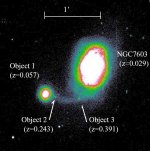Redshifts and the Hubble Law
A Summary of Halton Arp’s Ideas by Paul Ballard
In 1924 Edwin Hubble demonstrated that the small hazy patches of light we see in the sky are “enormous islands of billions of stars.” Examination with large telescopes revealed that the fainter and smaller a galaxy appeared, the higher, in general, was its redshift.
‘Redshift’ describes the characteristic lines in the spectrum due to hydrogen, calcium and other elements which appear at longer (redder) wavelengths than in a terrestrial laboratory. The simple explanation attributes this effect to the recession velocity of the emitting source – like the falling pitch of a receding train whistle, the Doppler effect. It was therefore concluded that the fainter and smaller the galaxy, the more distant it is, and the faster it is moving away from us. This velocity interpretation of the redshift – the apparent brightness relation – forms the standard interpretation of the Hubble Law.
Einstein wrote equations at about this time that attempted to describe the behaviour of the entire universe, the totality of existence. His equations pointed to its probable instability. Gravitation was either strong enough to be in the process of contracting the universe, or too weak to prevent its expansion. Extrapolating these velocities back to the origin of time gave rise to the concept of the universe being created in a primeval explosion – the Big Bang cosmology.
According to Halton Arp, observations began to accumulate from 1966 that could not be accounted for by this conventional explanation of the redshift effect. Some extra-galactic objects had to have redshifts which were not caused by a recesson velocity.
At the very least, it seemed that some modification had to be made to the theory, but some influential specialists reacted very strongly to these anomalous observations. It was said they “violated the known laws of physics” and must therefore be wrong; that is to say, a useful hypothesis had been enshrined in dogma. Arp states that the dogmatists attitude was akin to saying ‘At this moment in history we know all the important aspects of nature we shall ever know.’
The first challenge to the conventional theory came with the advent of radio astronomy and the discovery of quasars (quasi-stellar objects). It was no longer possible to view galaxies just as relatively quiescent aggregates of stars, gas and dust, all swirling in ordered rotation. Some are ripped asunder by huge explosions while others have nuclei that vary strongly in brightness and intermittently eject quantities of matter into space. The first quasar was discovered by Allan Sandage and Thomas Matthews, an optical and a radio astronomer working in collaboration, in 1963. Then, to great surprise, Martin Schmidt found that the initially puzzling lines were those of familiar elements but shifted far to the right. Why, when the highest redshifted galaxies had a maximum redshift of 20 to 40 percent of the velocity of light, did these stellar-looking objects suddenly appear with redshifts of 80 to 90 percent? It was conjectured that some other mechanism was responsible. For example, redshifting could be caused by a very strong gravitational field. However, such explanations were quickly discarded; it was decided that quasars were the most luminous objects in the universe and that they were seen at such great distances that the expansion of the universe was giving them the largest possible recession velocity.
Difficulties in this explanation were encountered almost immediately. Firstly, how could an object be so luminous? So much energy had never been encountered in previously observed galaxies. In some quasars the calculated density of charged particles was so high that there would be a problem of actually getting the photons, by which we see them, out of their interior. Very accurate positional measurements by radio telescopes (using very long baseline interferometry) revealed the astounding fact that some quasars appeared to be expanding at up to ten times the speed of light. This was in complete violation of the accepted laws of Einsteinian physics, in particular, that the speed of light is a physical constant that cannot be exceeded. Rather than regard these quasars as being at lesser distances so as to give them quite modest expansion velocities, conventional theorists attempted to incorporate the redshift effect into their existing beliefs. They attempted to explain these anomalies as an illusion caused by very exceptional conditions, such as ejection of matter towards the observer at nearly the speed of light. They ignored the direct evidence that these quasars were interacting with galaxies which were at a known and much nearer distance to us.
As observations of quasars accummulated it became apparent that anomalies existed between their brightness and their distribution. One would expect quasars to be evenly distributed in the universe, but a disproportionate number appeared to be near its observable limit. These quasars are also brighter than expected. This gave rise to another bizarre explanation: it was suggested that as we looked out in space, and therefore back in time, we encountered a higher and higher density of quasars until suddenly, at a certain point, they ceased to exist!
The orthodox view is that quasars are just abnormal (e.g. superluminous) galaxies and that they can only have a redshift caused by velocity. Arp drew attention to quasars interlinking with galaxies. But a large body of opinion now holds that galaxies can violate the redshift distance-relation. It is the most peculiar galaxies, those most like quasars, which offer the most compelling evidence for non-velocity redshift.
This has two consequences, first it enormously strengthens the case that the redshift-distance law can be broken. It only requires one demonstrably inconsistent quasar or galaxy to establish that an additional cause of redshift – other than recession velocity – must be in operation. Because of the connection of quasars with galaxies, there are now several cases of observations that another origin of redshift exists.
Secondly, it means that the mechanism for causing this non-velocity shift must be capable of operating on an entire conglomeration of stars, gas and dust. This is much more difficult than finding a mechanism which operates on the more compact and mysterious quasars.
Interpretations
Arp gives many examples of non-velocity redshift. He then attempts to integrate his observations into the body of existing scientific knowledge, following the Brownian principle of induction of general laws as far as possible. If a scientist only reasons deductively from known laws he will never discover anything new, argues Arp. He suggests that not knowing a thing is wrong may be more important than knowing a hundred things are right.
Central to Arp’s disagreement with accepted theory is the fact that redshifts of extragalactic objects are not caused by velocity alone. There are numerous examples of this in quasars with redshifts approaching the velocity of light, of peculiar galaxies with redshifts from 1,000 to 30,000 km/sec and in more normal, companion galaxies in the range of a few hundred km/sec.
The evidence clearly indicates that quasars have been ejected from active galaxy nuclei along with radio waves and x-rays. In view of the popularity of the notion of gravitational lensing Arp suggests instead that some gravitationally compact bodies are being ejected and that these ejected bodies are simply gravitationally amplifying objects in the far background which have a redshift caused by a recession velocity. This idea seems attractive, but does not explain galaxies with inconsistent redshifts. These galaxies seem to be interacting with much lower redshift galaxies so they must both be at the same distance from us.
Arp postulates that the strong gravitional fields of large masses within individual quasars and discrepant galaxies account for large redshifts, but points out that even for typical quasars like ZC48, nebulosity around the nucleus is measured at about the same redshift as the nucleus. There is no redshift gradient and no apparent internal gravitational field.
There have been many variations of ‘tired light’ theories put forward. The basic idea is that light from extragalactic objects travels a long way through space before reaching us. In that journey, if anything interacts with the photon or if its energy decays with the passage of time, it will arrive with a smaller energy than it started with, i.e. it will be redshifted. The main difficulty with this model is that to rob a photon of some of its energy it must be jostled or perturbed, at least slightly. This means that its flight path is slightly deviated and the image of the emitting object becomes fuzzy. However, there is no evidence for this and high redshift objects appear as clear and sharp as low redshift objects.
Whether gravitational fields result in collisions or perturbations which detract energy from photons or not, Arp postulates a “screen” between us and the object which removes, in discrete amounts, energy from the photons coming towards us. This leads to a model of shells of matter around redshifted objects, but he considers this a very artificial model.
What can be the cause of light from one object being redshifted relative to another, in the many cases of high redshift or otherwise peculiar galaxies interacting with normal, low redshift galaxies? The stars, gas and dust in one object emit light redshifted relative to the other with which it interacts.
This means that, for example, an atom of hydrogen in a high redshifted object, which makes a given transition from one energy state to the other, must emit or absorb a photon of lesser energy than the same atom would in a lower redshifted one. What determines the transition energy between the two atomic states? One factor is the relative charge between the electron and the nucleus. The other factor is the mass of the electron making the transition between two possible orbital states. Measurements of quasar spectra appear to rule out the possibility that the electric charges are different. This leaves only the mass of the electron.
Arp poses the question: Is the mass of the high redshifted object less than that of the low redshifted object?



